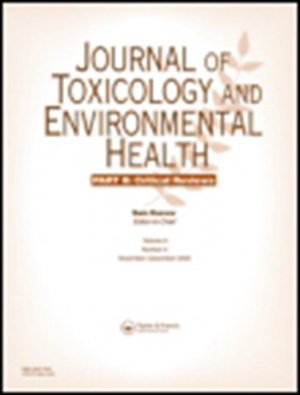使用体外人体皮肤模型对职业性化学品的水基皮肤去污效果的系统评价。
IF 6.4
2区 医学
Q1 ENVIRONMENTAL SCIENCES
Journal of Toxicology and Environmental Health-Part B-Critical Reviews
Pub Date : 2021-10-03
Epub Date: 2021-07-26
DOI:10.1080/10937404.2021.1957048
引用次数: 5
摘要
化学物质经皮吸收是局部和全身毒性的潜在途径。皮肤去污通过去除皮肤表面的污染物来中断这一过程。使用纯水或肥皂和水溶液进行净化是目前的黄金标准,尽管功效数据有限。综述了评估其在体外人体皮肤模型中去污职业性污染物的功效的研究。我们检索了Embase、MEDLINE、PubMed、Web of Science和Google Scholar,从15项调查中提取了相关文章和数据,这些调查报告了21种职业污染物,这些污染物进一步被分类为工业化学品、药物或杀虫剂。在4.3% (n = 6/140)的皮肤样本中,纯水去污无效,95.7% (n = 134/140)的皮肤样本部分去污无效。肥皂和水去污的皮肤样本完全去污率为4.9% (n = 13/264),部分去污率为95.1% (n = 251/264)。四项研究(26.7%,n = 4/15)报告了去污后污染物的渗透率或皮肤浓度增加,证明了“冲洗”效应。不同的研究方法阻碍了我们比较数据和确定什么时候单独使用水或肥皂和水最好的能力。国际统一的疗效协议可能会增强我们对去污的理解,并使去污临床实践和研究更有针对性。本文章由计算机程序翻译,如有差异,请以英文原文为准。
Efficacy of water-based skin decontamination of occupational chemicals using in vitro human skin models: a systematic review.
ABSTRACT Percutaneous absorption of chemicals is a potential route of topical and systemic toxicity. Skin decontamination interrupts this process by removing contaminants from the skin surface. Decontamination using water-only or soap and water solutions is the current gold standard despite limited efficacy data. A summary of studies evaluating their efficacy in decontaminating occupational contaminants from in vitro human skin models is presented. Embase, MEDLINE, PubMed, Web of Science, and Google Scholar were searched for relevant articles and data extracted from 15 investigations that reported on 21 occupational contaminants, which were further classified as industrial chemicals, drugs, or pesticides. Water-only decontamination yielded no response in 4.3% (n = 6/140) and partial decontamination in 95.7% (n = 134/140) of skin samples. Soap and water decontamination yielded complete decontamination in 4.9% (n = 13/264) and partial decontamination in 95.1% (n = 251/264) of skin samples. Four studies (26.7%, n = 4/15) reported increased penetration rates or skin concentration of contaminants following decontamination, demonstrating a “wash-in” effect. Varying study methodologies hinder our ability to compare data and determine when water alone or soap and water are best used. International harmonized efficacy protocol might enhance our decontamination understanding and enable a more customized approach to decontamination clinical practice and research.
求助全文
通过发布文献求助,成功后即可免费获取论文全文。
去求助
来源期刊
CiteScore
13.80
自引率
6.90%
发文量
13
审稿时长
>24 weeks
期刊介绍:
"Journal of Toxicology and Environmental Health: Part B - Critical Reviews" is an academic journal published by Taylor & Francis, focusing on the critical examination of research in the areas of environmental exposure and population health. With an ISSN identifier of 1093-7404, this journal has established itself as a significant source of scholarly content in the field of toxicology and environmental health.
Since its inception, the journal has published over 424 articles that have garnered 35,097 citations, reflecting its impact and relevance in the scientific community. Known for its comprehensive reviews, the journal also goes by the names "Critical Reviews" and "Journal of Toxicology & Environmental Health, Part B, Critical Reviews."
The journal's mission is to provide a platform for in-depth analysis and critical discussion of the latest findings in toxicology, environmental health, and related disciplines. By doing so, it contributes to the advancement of knowledge and understanding of the complex interactions between environmental factors and human health, aiding in the development of strategies to protect and improve public health.

 求助内容:
求助内容: 应助结果提醒方式:
应助结果提醒方式:


